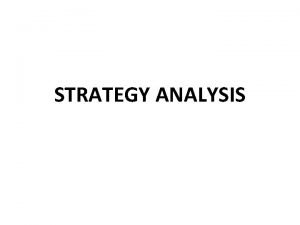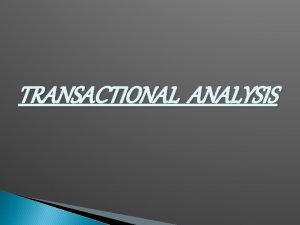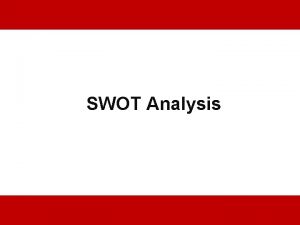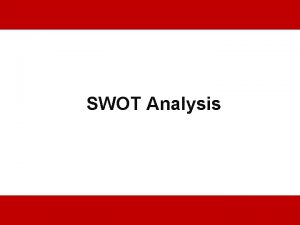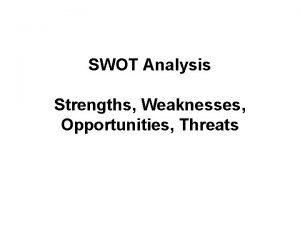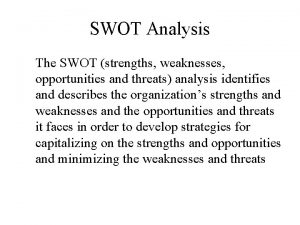STRATEGY ANALYSIS SWOT Strengths identifying existing organisational strengths










- Slides: 10

STRATEGY ANALYSIS

SWOT • Strengths – identifying existing organisational strengths • Weaknesses – identifying existing organisational weaknesses • Opportunities – what market opportunities might there be for the organisation to exploit? • Threats – where might the threats to the future success come from?

PEST • Political: local, national and international political developments – how will they affect the organisation and in what way/s? • Economic: what are the main economic issues – both nationally and internationally – that might affect the organisation? • Social: what are the developing social trends that may impact on how the organisation operates and what will they mean for future planning? • Technological: changing technology can impact on competitive advantage very quickly!

PEST • Examples: • Growth of China and India as manufacturing centres • Concern over treatment of workers and the environment in less developed countries who may be suppliers • The future direction of the interest rate, consumer spending, etc. • The changing age structure of the population • The popularity of ‘fads’ like the Atkins Diet • The move towards greater political regulation of business • The effect of more bureaucracy in the labour market

Five-Forces • Developed by Michael Porter: forces that shape and influence the industry or market the organisation operates in. – Strength of Barriers to Entry - how easy is it for new rivals to enter the industry? – Extent of rivalry between firms – how competitive is the existing market? – Supplier power – the greater the power, the less control the organisation has on the supply of its inputs. – Buyer power – how much power do customers in the industry have? – Threat from substitutes – what alternative products and services are there and what is the extent of the threat they pose?

Required Inputs • Changing strategy will impact on the resources needed to carry out the strategy: • Specifically the impact on: – Land – opportunities for acquiring land for development – green belt, brownfield sites, planning regulations, etc. – Labour – ease of obtaining the skilled and unskilled labour required – Capital – the type of capital and the cost of the capital needed to fulfil the strategy

Types of Strategy • Competitive Advantage – something which gives the organisation some advantage over its rivals • Cost advantage – A strategy to seek out and secure a cost advantage of some kind - lower average costs, lower labour costs, etc.

Types of Strategy • Market Dominance: • Achieved through: – Internal growth – Acquisitions – mergers and takeovers • New product development: to keep ahead of rivals and set the pace • Contraction/Expansion – focus on what you are good at (core competencies) or seek to expand into a range of markets?

Types of Strategy • Price Leadership – through dominating the industry – others follow your price lead • Global – seeking to expand global operations • Reengineering – thinking outside the box – looking at news ways of doing things to leverage the organisation’s performance

Types of Strategy – Internal business level strategies – • Downsizing – selling off unwanted parts of the business – similar to contraction • Delayering – flattening the management structure, removing bureaucracy, speed up decision making • Restructuring – complete re-think of the way the business is organised
 Identifying and non identifying adjective clauses
Identifying and non identifying adjective clauses How to identify clauses
How to identify clauses Identify the essential
Identify the essential Organisational strengths
Organisational strengths Transactional analysis in organisational behaviour
Transactional analysis in organisational behaviour Organisational feasibility analysis
Organisational feasibility analysis Levels of analysis of organisational behaviour
Levels of analysis of organisational behaviour Use case description
Use case description Objectives of secondary education commission 1952-53
Objectives of secondary education commission 1952-53 The similarity of ending sounds existing between two words
The similarity of ending sounds existing between two words Existing system of gym management system
Existing system of gym management system



